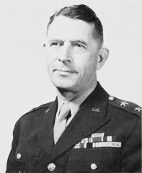
Ralph Corbett Smith (1893 – 1998) was a son of Nebraska who was an early military aviator (Orville Wright personally signed his pilot’s license) and a member of the Colorado National Guard while attending Colorado State College.
Smith received his U.S. Army commission in the Corps of Infantry in 1916. His initial service involved participation in the Mexican Punitive Expedition under Brigadier General John J. Pershing. Although the mission was unsuccessful, Smith learned essential leadership and combat efficiency lessons.
During World War I, while serving with the U.S. Sixteenth Infantry Regiment, Ralph Smith was recognized for displaying courage under fire by the award of two silver star pins affixed to the World War I Victory Medal.
Note: The Silver Star Medal was not authorized as the nation’s third-highest combat decoration until 1932. However, during World War I, senior Army commanders realized that recognition of excellence in combat was desirable and necessary to maintain high morale among the forces. At the time, there was only one combat decoration: the Medal of Honor. Service members whose courage did not rise to the level of the MOH received no recognition.
Consequently, General Pershing’s headquarters began issuing certificates of merit to individuals who demonstrated gallantry on the battlefield. At war’s end, the Army decided to award silver star pins to those who previously received certificates of merit. The pins were displayed on the ribbon portion of the World War I Victory Medal. Once the Silver Star Medal was created in 1932, individuals previously authorized to display silver star pins were granted authority to wear the newly created Silver Star Medal.
Later, the Army reassigned Smith to the U.S. 4th Infantry Division. Wounded in action during the Meuse-Argonne offensive, he would later be entitled to the Purple Heart Medal (created by Douglas MacArthur in the mid-1920s from a design by George Washington during the Revolutionary War). Following the war and occupation duty in Germany, the Army assigned Smith to advanced studies at the University of Paris and the Ecole Militaire. Smith was an instructor at the United States Military Academy between world wars and attended and taught at the Command and General Staff School at Fort Leavenworth, Kansas.
At the beginning of World War II, Smith served as a temporary Colonel. The Army advanced him to brigadier general and assigned him to the U.S. 76th Infantry Division. As the war progressed, General Smith assumed command of the 27th Infantry Division, the unit charged with the defense of the outer Hawaiian Islands.
In November 1943, Smith’s division was assigned to the V Amphibious Corps (5AC), Pacific Fleet, joining the 2nd Marine Division and 4th Marine Division in campaigns designed to destroy enemy Japanese forces in the Gilbert Islands. In 1944, 5AC invaded the island of Saipan. When General Smith failed to execute the operations plan according to the satisfaction of the Corps Commander, General Smith was relieved of his duty, and he was transferred to the Hawaiian Islands, where he commanded the U.S. 98th Infantry Division.
Later, after serving as the commander of the Army Replacement Center, General Smith served as military attaché in Paris, France. He retired from the Army in 1948. After retirement, he served as a fellow at Stanford University’s Hoover Institution. He passed away in 1998, the last surviving U.S. general officer to serve in World War II. He was 104 years old.
(Continued next week)
Sources:
- Gailey, H. A. Howlin’ Mad vs. The Army: Conflict in Command Saipan, 1944. Dell Publishing, 1987.
- Goldberg, H. J. D-day in the Pacific: The Battle of Saipan. Indiana University Press, 2007.

Mustang, Sir …I did know about Howlin’ Mad, Smith. Until now, I don’t recall hearing about this controversy or about General R.C. Smith. You’ve got me hooked, I’m waiting to see where this goes.
LikeLike